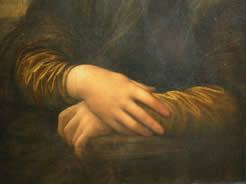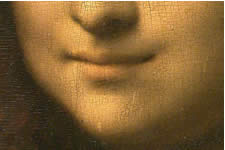
Mona Lisa. La Gioconda. La Joconde. While some may debate its rightful name, few would question that Da Vinci’s masterpiece is today the most famous painting in the world, although quite why or how it has acquired its iconic status is far less clear. Perhaps it is because so few genuine da Vinci paintings (perhaps 15) survive today. Perhaps it is because the Mona Lisa displays a technical mastery and daring composition that few, if any, have ever surpassed.
Or maybe the answer lies in the fact that almost everything about the painting is shrouded in obscurity.
What’s in a name?
Take her name. As described above, today she has at least three, although up until the mid-19th Century, she had none, being mainly referred to by various descriptive phrases, such as “a certain Florentine lady” and “a courtesan in a gauze veil”.
The name Mona Lisa can be traced back to the famous Renaissance biographer Georgio Vasari, who claimed that the sitter was Lisa Gherardini, wife of the rich Florentine Merchant Francesco del Giocondo, who had commissioned the portrait from Da Vinci in 1502. Thus Mona Lisa was derived from the common Italian contraction of Madonna, meaning my lady, or Mrs Lisa. La Gioconda meanwhile (and the French translation La Joconde) is simply the feminine form of Giocondo, although this could perhaps be a coincidence – giocondo also means ‘jocund’, so this traditional name for the painting could in fact have originated as another purely descriptive title – the witty or playful one, the joker-lady, perhaps even the tease.
The debate over the name stems from continuing uncertainty over the identity of the sitter. Alternative suggestions have ranged from Isabelle d’Este; Constanza d’Avalos, duchess of Francavilla (coincidentally also nicknamed ‘La Gioconda’); Isabella of Aragon, the Duchess of Milan; to da Vinci himself, his mother Caterina or even one of his gay lovers. This sexual ambiguity is not helped by the Mona Lisa’s lack of facial hair which gives her a slightly androgynous look. It is unclear if this was deliberate (as facial hair on genteel women was considered unsightly at the time), or if Leonardo simply did not finish the painting, as is the case with almost all of his works.
The confusion is worsened by the fact that the panel is unsigned and undated (Vasari claims that da Vinci painted it between 1503 and 1507, although some believe it was started as early as 1489 or as late at 1513). And although most portraits of the time included something to indicate the sitter’s family name or social status, no such emblem can be found in the Mona Lisa. Nor is there any record of a commission for the portrait among Leonardo’s papers.
In a final twist, some have even speculated that da Vinci created more than one version of the painting, with some early copies (e.g. at the Dulwich Picture Gallery) showing columns to either side of the seated figure, while only the edges of the bases can be seen in the original. In other versions the sitter appears nude, leading some to speculate that they were copied from a lost Leonardo original depicting Lisa naked.
The road less travelled
If its genesis is uncertain, the Mona Lisa’s subsequent movements are well documented and surprising in how little the painting has moved around compared to most other Renaissance works. Da Vinci took the painting to France with him in 1516 when François I offered him his patronage, eventually selling it to the king when on his death bed for 4,000 écus.
François installed it in the Apartement des Bains at the royal palace of Fontainebleau, where it remained until moved by Louis XIV to Versailles. His son, Louis XV, hated it however, and ordered it removed from the palace. For a time it was in the hands of a palace bureaucrat and after having been hidden in a warehouse during the chaos of the French Revolution, it was installed in the Louvre where it has remained ever since apart from a brief period when Napoleon insisted on hanging the painting in his bedroom in the adjacent Tuileries palace.
Since then, the painting has been moved only five times:
Twice when it was stored for safe-keeping during the Franco-Prussian War of 1870–1871 and the Second World War. Twice when it went on tour to the United States in 1962/63 and to Tokyo and Moscow in 1974. And once, of course, when it was stolen in 1911.
Da Vinci’s unique vision
Da Vinci used a pyramid design to place the woman simply and calmly in the space of the painting, modifying the simple formula of the seated Madonna which was in common use at the time. The enigmatic woman is portrayed seated in what appears to be an open loggia with dark pillar bases on either side.

The armrest of the chair functions as a dividing element between Mona Lisa and us and she sits very upright with her arms folded, a sign of her reserved posture. At the same time, however, the framing of the Mona Lisa’s face by much darker elements (her hair, veil and shadows), attracts the eye to her. This creates an ambiguous effect on the observer as we are both drawn to her and held at a distance
The sensuous curves of the woman’s hair and clothing, created through da Vinci’s mastery of sfumato, are echoed in the undulating imaginary valleys and rivers behind her – Da Vinci was one of the first painters to place their subject in an imaginary landscape, a vast landscape receding to icy mountains behind her and winding paths and a distant bridge giving only the slightest indications of human presence. The blurred outlines, graceful figure, dramatic contrasts of light and dark, and overall feeling of calm are characteristic of Leonardo’s style and his belief in a cosmic link connecting humanity and nature.

Mona Lisa’s smile has been the subject of many – greatly varying – interpretations. Unsurprisingly, Freud interpreted the ‘smile’ as signifying Leonardo’s erotic attraction to his mother, while others have described it as both innocent and inviting.
Many researchers have tried to explain why her smile is seen so differently by people. Dina Goldin, Adjunct Professor at Brown University, for example, has argued that the secret is in the dynamic position of Mona Lisa’s facial muscles, where our mind’s eye unconsciously extends her smile; the result is an unusual dynamicity to the face that invokes subtle yet strong emotions in the viewer of the painting. In late 2005, Dutch researchers from the University of Amsterdam ran the painting’s image through an “emotion recognition” computer software which found the smile to be 83% happy, 9% disgusted, 6% fearful, 2% angry, less than 1% neutral, and 0% surprised.
In 2004 experts from the National Research Council of Canada conducted a three-dimensional infrared scan which suggested that the transparent gauze veil worn by the sitter is a guarnello, typically used by women while pregnant or just after giving birth, and therefore concluded that the Mona Lisa’s enigmatic smile is that of a glowing, pregnant woman.
Fame and fortune
Vasari notes that even in da Vinci’s day, artists came from far and wide to study the Mona Lisa in amazement. The young Raphael was reportedly so fascinated by Leonardo’s composition that he created a series of Florentine portraits, several of which display a striking resemblance to the Mona Lisa.
However, the painting only really came to mass-prominence in the mid-19th century, when artists of the emerging Symbolist movement began to appreciate it, and associated it with their ideas about feminine mystique. Catapulted to international notoriety by its theft in 1911 [click here for more] the Mona Lisa has come to occupy a unique position in popular culture, from Dadaist pin-up girl, to Andy Warhol screen print, to featuring in the Monty Python opening credits and “starring” in the Muppet Show.
Today, according to Louvre Curator Jean-Pierre Cuzin, the painting’s importance is due more to the seminal role it has played in the history of painting:
“The entire history of portraiture afterwards depends on the Mona Lisa. If you look at all the other portraits – not only of the Italian Renaissance, but also of the seventeenth to nineteenth centuries – if you look at Picasso, at everyone you want to name, all of them were inspired by this painting. Thus it is sort of the root, almost, of occidental portrait painting.”
Because of this, there is no reliable estimate of the value of the Mona Lisa. Prior to the 1962-63 tour to America, it was assessed for insurance purposes at $100 million. According to the Guinness Book of Records, this makes it the most valuable painting ever insured and only recently been surpassed (in terms of actual dollar price) by three other paintings:
- – the Adele Bloch-Bauer I by Gustav Klimt, which was sold for $135 million (£73 million)
- – Woman III by Willem de Kooning which sold for $137.5 million
– No. 5, 1948 by Jackson Pollock which sold for a record $140 million.
This comparison does not, however, account for the change in prices due to inflation – $100 million in 1962 is approximately $670 million in 2006 when adjusted for inflation.
However, fame has come at a cost. In 1956, the lower part of the painting was severely damaged when someone doused it with acid. On December 30 of that same year, Ugo Ungaza Villegas, a young Bolivian, damaged the painting by throwing a rock at it. This resulted in the loss of a speck of pigment near the left elbow, which was later painted over.
Today
Today, to protect her from further attacks, the painting is displayed in a purpose-built, climate-controlled enclosure behind bullet proof glass in the newly refurbished Salle des États, just off the Grande Gallerie.
But the true cost of her fame is perhaps felt most by those who go to see her. As Cuzin says
“The problem is she has become so famous that we don’t really see her anymore. What would be extraordinary would be to see the Mona Lisa for the very first time, as if you had never seen her before.”




